| Columns Retired Columns & Blogs |
McCormack Audio UDP-1 universal disc player Measurements
Sidebar 3: Measurements
I looked only at the main left and right outputs. To my surprise, the McCormack offered a lower maximum output level from SACD than it did from CD or DVD-Audio: 1.99V vs 2.35V. This is a difference of almost 1.5dB, which, if not compensated for, will mess up any direct comparisons of SACD and DVD. In addition, the UDP-1's output inverts signal polarity, which will be a confusing factor in comparisons with other players. McCormack doesn't specify the output impedance; I measured 319 ohms across most of the audioband, this rising to 500 ohms at 20Hz. As long as the preamplifier has an input impedance of 10k ohms or greater, the UDP-1 will not suffer from lean-bass syndrome.
The UDP-1's CD replay offered the usual flat response with both normal and pre-emphasized recordings (fig.1). With hi-rez media, the ultrasonic responses with SACD and DVD-A differed (fig.2). The DVD-A data show a flat response up to 42kHz, with then a sharp rolloff, while the SACD data roll off more slowly, being 1dB down at 45kHz, –3dB at 62kHz. Channel separation (fig.3) was superb, at better than 120dB below 2kHz, and still better than 100dB at 20kHz. Error correction was only fair, the UDP-1's output suffering audible glitches with gaps in a CD data spiral 0.75mm in length.
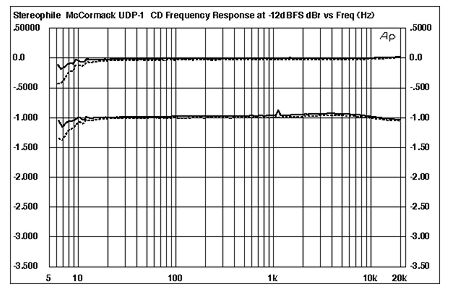
Fig.1 McCormack UDP-1, CD data, frequency response at –12dBFS into 100k ohms, with de-emphasis (bottom) and without (top). (Right channel dashed, 0.5dB/vertical div.)
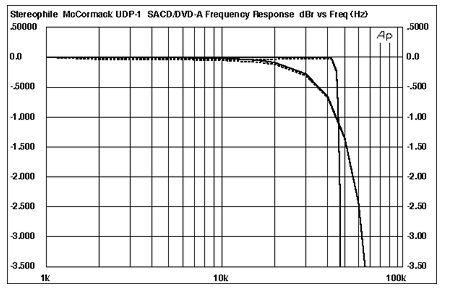
Fig.2 McCormack UDP-1, DVD-A (top at 30kHz) and SACD data, frequency response at –3dBFS into 100k ohms (right channel dashed, 0.5dB/vertical div.).
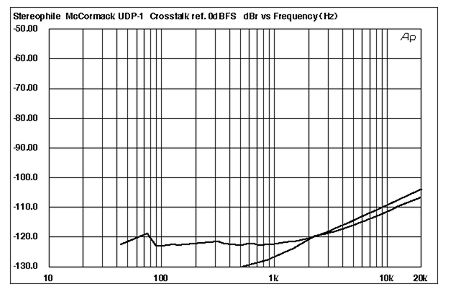
Fig.3 McCormack UDP-1, channel separation.
While I disagree with those conservative audio commentators who write that the increased resolution offered by 24-bit/96kHz LPCM or DSD does not offer audible benefits, I do feel that the new media players are obliged to preserve that resolution. And here the UDP-1 stumbled. Fig.4 shows 1/3-octave spectral analyses of the player's output while it decoded dithered data representing a 1kHz tone at –90dBFS. Usually, 24-bit data give a much lower noise floor than 16-bit, which you can see in this issue's measurements of the dCS Delius D/A processor. However, as shown by fig.4, the McCormack's noise floor is only a dB or so lower with 24-bit DVD-A data than it is with 16-bit CD data. If a DVD-A contains true hi-rez data—a big "if"—the McCormack will not resolve those data.
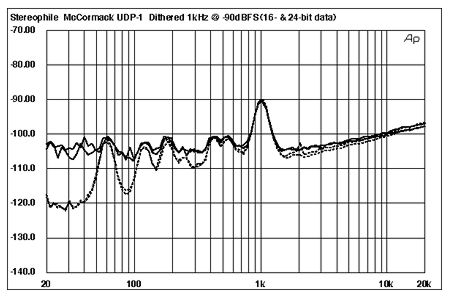
Fig.4 McCormack UDP-1, 1/3-octave spectrum of dithered 1kHz tone at –90dBFS, with noise and spuriae, 16-bit CD data (top) and 24-bit DVD-A data (bottom). (Right channel dashed.)
How about SACD playback? Fig.5 shows the spectrum resulting from playing back a tone at –90dBFS from a test SACD. Other than the rise in noise in the high treble due to the DSD encoding, this spectrum is identical to that in fig.4. The McCormack will not offer any more resolution from SACD than it does from CD or DVD. And note that in these two graphs, the left channel is noisier than the right at low frequencies, but that both channels are afflicted with power-supply components at the 60Hz line frequency and its harmonics. (The 60Hz and 180Hz components usually result from transformer hum injected into the audio circuitry; the 120Hz and 240Hz components result from suboptimal grounding within the player's chassis.) I experimented with various grounding arrangements between the UDP-1 and my Audio Precision System One, but could not reduce the power-supply noise below that shown in these graphs.
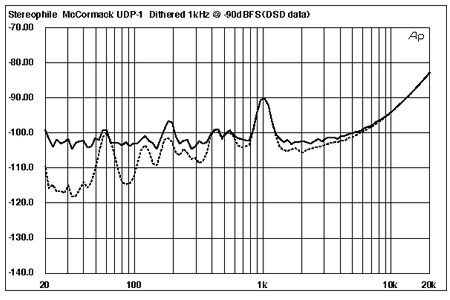
Fig.5 McCormack UDP-1, 1/3-octave spectrum of dithered 1kHz tone at –90dBFS, with noise and spuriae, DSD SACD data (right channel dashed).
With its relatively noisy output, it came as no surprise that the McCormack offered a high amount of low-level linearity error with 16-bit data (fig.6) and didn't do a good job of preserving the waveform of an undithered sinewave at exactly –90.31dBFS (fig.7). Again, almost perfect performance with these two signals can be seen in this issue's dCS review.
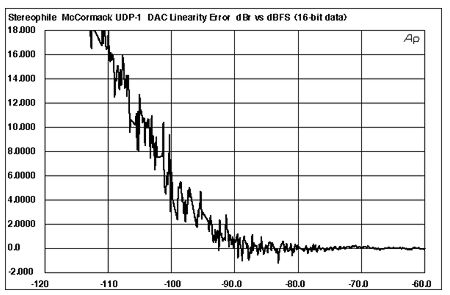
Fig.6 McCormack UDP-1, left-channel departure from linearity, 16-bit CD data (2dB/vertical div.).
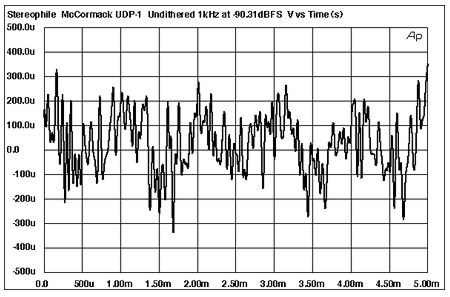
Fig.7 McCormack UDP-1, waveform of undithered 1kHz sinewave at –90.31dBFS, 16-bit CD data.
Turning to the McCormack's distortion performance, a full-scale 1kHz tone was reproduced with low levels of low-order harmonics, even when driving fairly low impedances (fig.8). This is commendable performance. Intermodulation distortion was also very low (fig.9).
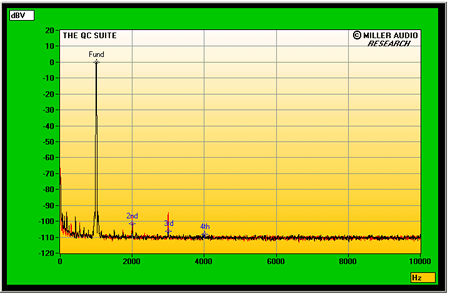
Fig.8 McCormack UDP-1, spectrum of 1kHz sinewave, DC–1kHz, at 0dBFS into 4k ohms, DSD data (linear frequency scale).
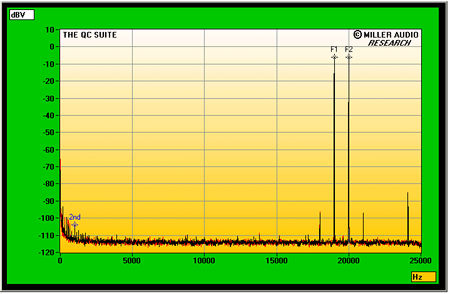
Fig.9 McCormack UDP-1, HF intermodulation spectrum, DC–25kHz, 19+20kHz at 0dBFS into 4k ohms, CD data (linear frequency scale).
I tested the UDP-1's rejection of word-clock jitter using a diagnostic tone sampled at 44.1kHz, which I burned to both CD-R (16-bit data) and a DVD-A–formatted DVD-R (24-bit data). The measured amount of clock jitter, calculated by the Miller Audio Research Analyzer looking at the player's analog output, was low. CD data resulted in 231 picoseconds peak–peak of jitter; DVD data, 182ps. However, as the spectra of the UDP-1's analog output show, not only are there jitter components present (indicated with purple markers), but there are many noise spikes, as well as a noise floor about 6dB higher than the best CD playback I have examined. There are also data-related sidebands present with the CD signal (fig.10, red numerical markers), but these are absent as expected with the 24-bit DVD signal (fig.11).
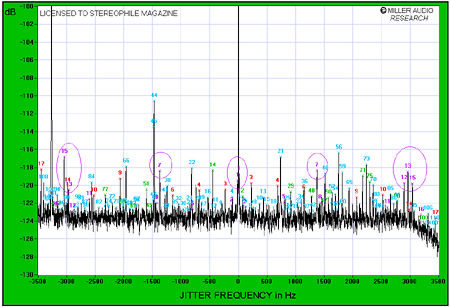
Fig.10 McCormack UDP-1, 16-bit CD data, high-resolution jitter spectrum of analog output signal (11.025kHz at –6dBFS sampled at 44.1kHz with LSB toggled at 229Hz). Center frequency of trace, 11.025kHz; frequency range, ±3.5kHz.
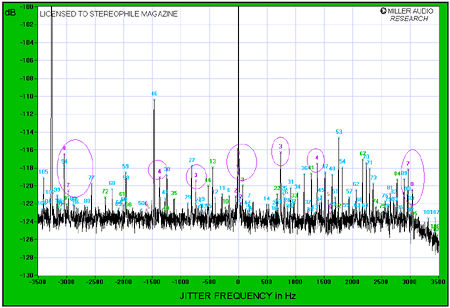
Fig.11 McCormack UDP-1, 24-bit DVD-A data, high-resolution jitter spectrum of analog output signal (11.025kHz at –6dBFS sampled at 44.1kHz with LSB toggled at 229Hz). Center frequency of trace, 11.025kHz; frequency range, ±3.5kHz.
I don't have the special diagnostic test signal recorded on SACD, but analysis of a high-level tone at exactly one quarter the sample rate (fig.12) gave a similar picture, with a highish, dirty-looking noise floor.
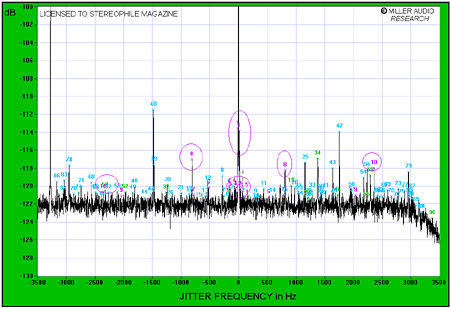
Fig.12 McCormack UDP-1, SACD data, high-resolution jitter spectrum of analog output signal (11.025kHz at –3dBFS). Center frequency of trace, 11.025kHz; frequency range, ±3.5kHz.
Having heard good things about the McCormack's sound quality from audiophiles whose opinions I respect, I was disappointed to find out that its intrinsic resolution is limited to the "Red Book" CD level. No matter how good a power supply McCormack has used, and how beefy an output analog stage it has added, the fundamental digital performance appears to be that of the OEM Pioneer circuitry at the player's heart. I am at a loss, therefore, to explain either why Kal liked the UDP-1's sound so much.— John Atkinson
- Log in or register to post comments




































